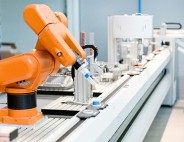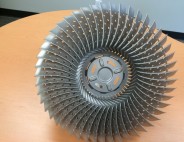Building the Future of Manufacturing
20 Feb, 2014
By Mark Kleszczewski
Game changing technology and new career paths require community support and investment.
The U.S. economy has been shifting from manufacturing to services for decades, but making tangible products still underpins the country’s ability to innovate, compete and create high-value jobs. American manufacturing has even begun enjoying a rebound in recent years, driven by a surge in low-cost energy production, a growing emphasis on quality and proximity to customers, and advances in technology.
The benefits of digitization and additive manufacturing — which creates three-dimensional shapes from the fused layers of materials ranging from polymer resins to metals — are increasing for today’s manufacturers. Rapid prototyping technologies have been in use for more than 20 years, but new developments in hardware and software are allowing them to be used for actual production, tooThe capabilities of an additive and digital manufacturing environment are going to be a game changer, says Ed Morris, vice president, NCDMM and director, America Makes – National Additive Manufacturing Innovation Institute (NAMII). “As additive manufacturing continues to accelerate and foster innovative product applications, digital manufacturing will also proliferate further.”
While most companies are still at the early stages of adopting next-generation techniques, some have aggressively embraced additive manufacturing for rapid, low-cost tooling, metal forming and manufacturing components used in major assemblies, Morris explains. Additive manufacturing to produce final products is also now a reality, especially in aviation parts, medical items such as braces and hip implants, and even integrated electronics.
Additive Becoming Big Business
According to Wohlers Associates, the greatest long-term impact of additive methods is expected to be in highly-customized manufacturing, where additive techniques can be more cost-effective than traditional methods. In its 2013 industry analysis, the consultancy notes that final part production rose to 28.3 percent of the $2.2 billion spent in 2012 on 3-D printing products and services worldwide, up from only 3.9 percent of revenues in 2003.
It took the 3-D printing industry 20 years to reach $1 billion in size. In five additional years, the industry generated its second $1 billion and is expected to double again, to $4 billion, in 2015. In less than four years, Wohlers Associates believes that the sale of 3-D printing products and services will approach $6 billion worldwide and $10.8 billion by 2021.
That kind of growth has major implications for domestic sourcing and distribution, particularly in the aerospace, defense, auto, and energy industries where weight, speed and efficiency are essential. The Boston Consulting Group estimates that 10 percent to 30 percent of the total goods now imported from China alone could be made in the United States, boosting domestic output by $20 billion to $55 billion annually.
“CNC is the vast majority of machining nowadays, but while a machine is often highly automated, it almost never knows other machines exist. Even in large or highly-automated factories, machines essentially perform a carefully coordinated, but blind ballet to make parts. The bulk of communication is along the lines of ‘go ahead’ or ‘I’m ready.’ The machines are ‘dumb’ and still require smart people to tell them what to do.” – Nick Pinkston, founder, Plethora
New Techniques, New Thinking
Today’s manufacturers may have mastered the production of high-value goods in an industrial environment, but to keep pace with tomorrow’s trends, they will have to adapt in everything from CNC milling to factory floor automation, all the way to system-wide integration at the production level, suggests Nick Pinkston, founder, Plethora.
“Specialization will continue to occur as factories get ever more unique,” Pinkston says. “A look at Apple is a look into the future; they lead their product categories by developing new and custom processes to produce lighter parts, higher-quality finishes and unique designs which are unachievable with off-the-shelf machinery and techniques.”
As competition increases, speed of development and speed to market will increase, product lifecycles will continue to shorten and the connection between engineering and manufacturing will grow tighter. “CAD software will become a lot more than just design with some simulation,” Pinkston predicts. “It will be a whole engineering environment that will let you not only design parts, but cost custom and off-the-shelf components and automate repetitive engineering tasks.
“CNC is the vast majority of machining nowadays, but while a machine is often highly automated, it almost never knows other machines exist,” Pinkston continues. “Even in large or highly-automated factories, machines essentially perform a carefully coordinated, but blind ballet to make parts. The bulk of communication is along the lines of ‘go ahead’ or ‘I’m ready.’ The machines are ‘dumb’ and still require smart people to tell them what to do.”
“Manufacturing is not all going to be automated — there’s still the human side of it,” adds Debbie Holton, managing director, SME. As the ‘industrial Internet’ grows, understanding how systems work together in the field will be important, so manufacturers will have little choice but to build up their IT capabilities and knowledge.
“The ability to interpret cloud-based predictive maintenance and manipulate the ‘digital thread’ of products — from initial design to final disposal — are just two examples of the skills growing in demand,” Holton continues. “Companies are going to go where the skills are, so in terms of economic development, education and training are going to be key for creating future growth in manufacturing.”
Communities Get Involved
A recent example of state-level attention aimed at supporting next-generation manufacturing is in Rhode Island, where back in December, the Rhode Island Commerce Corp. partnered with Bryant University, Rhode Island Manufacturing Extension Services and the Rhode Island Manufacturers Association to host a conference entitled, “3-D Printing: Promoting a Maker Culture in RI.”
“3-D printing is the next trillion-dollar industry,” says Andrew Coutu, president, R&D Technologies, a 3-D manufacturer based at Quonset Business Park. “If Rhode Island manufacturing companies want to be around in five years, they have to lean into it. We need to find ways to promote apprenticeships and learning programs to develop talent — and keep talent from leaving this state. Soon, everyone will have a 3-D printer in their home — it’s time to ride the wave of this new revolution in the manufacturing process.”
National attention and initiatives such as America Makes and the newly-launched Digital Manufacturing and Design Innovation Institute will certainly help, but investment and cooperation at the local level will help small and medium-sized manufacturers transition into additive and digital manufacturing technologies even more effectively.
Partnerships are also forming at the regional and local levels to help inventors, smaller manufacturers and suppliers take advantage of fast-changing additive and digital technologies. In Wayne County, Ohio, local leaders are collaborating to establish a manufacturing commercialization center and help manufacturers design new products, make hard-to-get items, hire trained staff and stay competitive in an evolving marketplace.
“Ohio is going through a manufacturing renaissance, so this is a concept we can all gather around,” says Rod Crider, president, Wayne (County, Ohio) Economic Development Council. “This is going to be a revolutionary technology for manufacturing and for the educational community, an opportunity for training.”
Crider says the effort took on even greater momentum after the council and other stakeholders including MAGNET (Manufacturing Advocacy & Growth Network), Ohio State University, and Wayne County Schools organized a 3-D Manufacturing Roundtable last October to plot a course for the future.
In addition to the production of actual goods, new economic activity is also being generated by additive and digital manufacturing OEMs themselves, as the sector grows. A notable example is 3-D Systems Corp. which announced a $10 million investment in October 2013 to expand its headquarters and manufacturing facility in Rock Hill, S.C.
Supported by state-approved job development credits and local property tax relief, the multi-year project is expected to generate 145 new jobs. The plans follow the company’s earlier move to expand local manufacturing of new personal and professional 3D printer models, and blending of proprietary print materials.
“To accommodate unprecedented demand for our products, we are expanding our manufacturing operations in the Charlotte region,” said Avi Reichental, president and CEO, 3-D Systems Corp., in a public statement. “We are literally manufacturing the future in Rock Hill and deeply appreciate all the support we’ve received from state and local officials.
“We are excited about the opportunity to expand our production capacity and services to our customers,” Reichental continued. “Rock Hill has been the perfect fit for our business, and we look forward to continuing to grow here.”
While public incentives helped offset the costs of relocating from California and Colorado, one of the biggest assets that attracted 3-D Systems Corp. to the region was York Technical College, which partnered with the company to create a 17,000-square-foot center for training in 3-D printing, rapid prototyping and rapid manufacturing skills.
Getting to the Cutting Edge
National attention and initiatives such as America Makes and the newly-launched Digital Manufacturing and Design Innovation Institute will certainly help, but investment and cooperation at the local level will help small and medium-sized manufacturers transition into additive and digital manufacturing technologies even more effectively.
“Electricity was so transformative to American manufacturing that it made the development of steam technology pale by comparison,” says Victor Schantz, president, Schantz Pipe Organ Co. in Orrville, Ohio. “What’s going on now in manufacturing is at least as revolutionary. However, when small manufacturing businesses like mine try to take on a new technology by themselves, they have to come up with the capital to invest in expensive machinery that quickly goes obsolete.
“They also have to train their own people and experiment with their own ideas, yet there’s nothing really to cushion them from failure,” Schantz continues. “In the next several years, what we hope will change is that collaboration between our educational institutions, government and businesses will provide a career path for the trained technicians that we need, and a less expensive way to access the latest in technology. The rust belt needs to bounce back and this is one way to do it.”
For complete details on the organizations featured in this article, visit:
Wayne (County, Ohio) Economic Development Council
Illustration by Stuart Miles at Free Digital Photos.net
Related Posts
-

Advanced MFG
-

Reshoring Essential to Manufacturing’s Renaissance
-

Additive Manufacturing on the Make
-

Manufacturing: Growth and Reshoring Shape 2015
-

What does Manufacturing Mean to You? Video
-

Makers Create the Future
-

Chicago is Overcoming Manufacturing’s Deeper Problem
-

Manufacturing: Welcome Back to the USA









